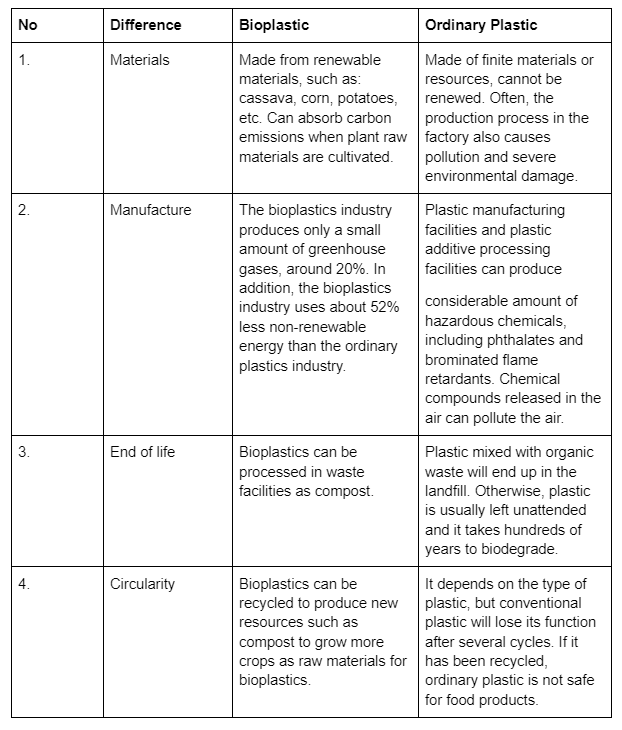Hyundai Motorstudio Senayan Park
Hyundai Motorstudio Senayan Park
Newsroom
The official news from Hyundai Motorstudio Senayan Park and a collection of innovative articles on mobility and sustainability here.
-
4 Differences Between Bioplastic and Conventional Plastic
- Hyundai Motorstudio Senayan Park Senayan Park 2022.09.08
-
In Indonesia, there are still many shops or businesses that offer plastic bags as packaging or shopping bags. You can choose two types of plastic bags, namely conventional plastic bags and plastic bags biodegradable bioplastic .
Maybe you are wondering, what is the difference between bioplastic and conventional plastic? Is it true that bioplastics are environmentally friendly? Then, how can we see the difference between bioplastics and conventional plastics? Immediately see the discussion below!
Burn Test to Distinguish Bioplastics and Conventional Plastics
If you look at the technology, there are conventional plastics that are environmentally friendly and can decompose faster than conventional plastics.
Although there are ordinary plastics that are biodegradable, the mechanism of decomposition in nature between bioplastics and conventional plastics is different. To see the difference between bioplastic and conventional plastic is not difficult. One way to do this is a burn test.
You don't need complicated equipment, just a simple tool, namely a flame from a candle or a match. Then, to prove it, light a candle, then burn a small piece of plastic to know the difference between bioplastic and conventional plastic.
If plastic burns continuously with a fire that continues to burn, it means that it is more difficult to decompose in nature. Meanwhile, if the fire is easily extinguished, it is easier to decompose. Generally, conventional chemical-based plastic will burn and the fire will continue to burn. Meanwhile, bioplastics made from plants, such as cassava or corn, will quickly extinguish the fire.
From the results of the combustion, ordinary people can distinguish between conventional plastics and bioplastics. The color of the combustion results both turn dark or black.
In addition, the difference between bioplastics and conventional plastics can be seen from the results of their combustion. Ordinary plastic will melt and the texture is tough, not easy to break when pressed or hit though. Meanwhile, bioplastics that are easily decomposed by combustion will be brittle and break easily when pressed.
It's easy, right, to see the difference between bioplastic and conventional plastic! This method can make it easier for ordinary people to quickly determine how to distinguish between bioplastics and conventional plastics.
Difference Between Bioplastic And Conventional Plastic
After understanding how to distinguish between bioplastic and conventional plastic with a burn test. Now, let's learn what the significant differences between bioplastics and conventional plastics are:
Advantages of Bioplastics Compared to Ordinary Plastics
Bioplastics are made from renewable materials, namely from compounds found in plants such as collagen, cellulose, casein, lipids or proteins.
Then, what are the advantages of this bioplastic compared to conventional plastic, including the following:
1. More Easily Decomposable By Microorganisms in Soil
It's a problem waste is increasingly complicated by the difficulty of plastic waste to decompose in a short time. Thus, causing garbage to accumulate.
With the emergence of bioplastics that decompose easily in a short time compared to plastics in general. This of course helps us overcome the problem of waste in the environment.
2. No Harmful Content of Environmental Pollutants
Generally, conventional plastics are made from processing fossil fuels which contain various harmful substances that pollute the environment. With the increasing number of problems caused by plastic waste, this is where the role of bioplastics made from organic materials comes into play.
Organic materials in bioplastics do not contain environmental pollutants, such as Bisphenol A and Styrene Treme, as well as derivatives from Polystyrene which are generally found in conventional plastics.
3. Reduced Demand for Fossil Fuels
The plastics that we generally use on a daily basis are processed from the processing of fossil fuels. In the process, of course, requires fossil fuels. It can be concluded that conventional plastics use fossil fuels, starting from the raw materials to the manufacturing process.
You can imagine how much fossil fuels are used for conventional plastic processing. This is different from bioplastics, which are made from organic materials, from plants or animals. Of course, these organic materials can be renewed, nature can decompose them, and are more environmentally friendly.
4. Reduced City Waste Volume
Currently, conventional plastic has become a part of people's lives around the world. However, plastic waste is also a serious problem because it takes time to biodegrade. As a result, the volume of plastic waste is getting bigger and bigger.
With bioplastics that can decompose in a short time compared to conventional plastics, this can be a solution to reduce plastic waste in cities.
Weaknesses of Bioplastics
Unfortunately, this environmentally friendly bioplastic also has several disadvantages, including:
1. Decomposes Only At 122⁰F / 50⁰C
Quoted from McGlade, chief scientist at the United Nations Environment Programme, many biodegradable plastics such as bioplastics in the form of shopping bags, will only decompose at 122⁰F/50⁰C and this is not ocean temperatures.
Bioplastic does not float, but will sink to the seabed. If the bioplastic is not exposed to the sun's UV rays, it is difficult to decompose.
2. Does not rot unless thrown away
The process of bioplastic decomposition requires special treatment. For example, processed in special facilities or buried in the ground. However, if bioplastics are only disposed of carelessly, new problems will arise.
Because in the process of decomposition, bioplastics still require special treatment by burying them in the soil so that microorganisms in the soil can decompose them.
That's some information regarding the difference between bioplastic with conventional plastic seen from the advantages and disadvantages. Hopefully the information above can add to your insight so that you start switching to bioplastics and reduce the use of ordinary plastics.
This small action certainly has an impact on the surrounding environment and don't forget to bury bioplastic waste.





